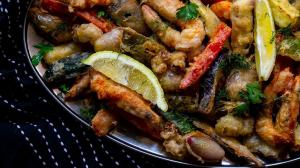Another TEMPURA-STORY . . . again ! Even though we talked about this about 6 weeks ago when we were focusing on stuffed & deep-fried zucchini flowers that I brought back from Marseille (see the recipe here) I’m still rather obsessed with this method, so here we go again. So JAPANESE, right ?! And yet so PORTUGUESE, right ?! Here’s the mini short-story version : Portuguese Jesuit missionaries in Japan in the 16thcentury, they make PEIXINHOS DA HORTA (which literally translates into LITTLE FISHES FROM THE GARDEN) which were just lightly battered and deep-fried vegetables ... the Japanese adored and adopted them. And the rest is history . . .
Here’s my understanding after much research and testing. I’m not a “purist” either so I incorporated modifications. I think people should prepare stuff the way they like and not necessarily adopt the usual and/or traditional way. Do we agree ?!
TEMPURA is not supposed to be complicated. The batter usually has a ratio of 1 part dry ingredients (in weight) to 2 parts liquid ingredients (in weight) or equal volumes of each.
The ingredients don’t have to be complicated either. It can very simply be 1 cup of high-starch and low protein flour(s) and 1 cup of cold sparkling water, but that’s boring.
The flour(s) used should be low in protein to inhibit gluten development, like cake & pastry flour, but you could add more starches to the dry mix such as cornstarch or rice flour if you use all-purpose flour (in order to lower the protein/gluten content) and make it lighter. Then of course some addition of salt, pepper and maybe baking powder and/or baking soda if the sparkling soda isn’t bubbly enough.
Extra spices are a personal choice and should be finely ground. I chose the fennel, anis and celery seeds for that extra ‘greeny freshness’. You could add them directly into the dry ingredients or let them infuse in the alcohol beforehand for more intensity (which is better) and then add them to the rest of the liquid ingredients for the batter. It’s a subtle hint of extra flavor.
The liquid ingredients can be chilled water (but you’ll need to add more baking powder and baking soda) but cold sparkling soda water is best (but beer and champagne could be lovely too, but that’s a question of wealth and social standing) and adding a beaten egg white to the batter improves the airiness and final result. Use that remaining egg yolk and some olive oil to bind it all together for some extra flavor and for a deeper golden color. The OUZO (or any other very strong anise alcohol) adds a bit of flavor but is especially useful because it evaporates very quickly when frying for a crispier and less greasy end result.
The batter is thin, light and airy and will only become a thin coating on the fresh vegetables and seafood that should still be partly visible and recognizable. Your batter weight should be equal to half the weight of the foods you’ll be dipping and frying. It’s a light preparation so the batter should not overpower the foods and the deep-frying should not overcook them either.
The foods to be battered and deep-fried should be at room temperature, the batter should be cold, the oil very hot.
Some salt and maybe an acidic lemon and vinegar marinade beforehand will flavor the vegetables and seafood to be fried by accentuating their flavors (but it’s not absolutely necessary), adding “sharpness” but especially also eliminating or pulling out some of the excess water in the foods to be fried. Intensity is key ! Don’t forget to pat them dry and/or sprinkle with more cornstarch to absorb extra surface moisture right before battering and frying. Pre-battering dryness is key too.
And when serving, add a few lemon or lime slices and a sprinkling of fresh aromatic herbs on top (because everybody likes that and it makes them feel better and the whole preparation seem so much lighter and fresher and summery) … SUN-DRENCHED ILLUSIONS.
That’s my TEMPURA-STORY !
So what’s yours ? . . . :)












